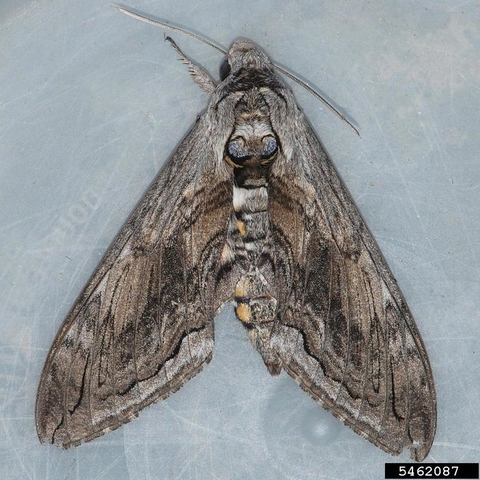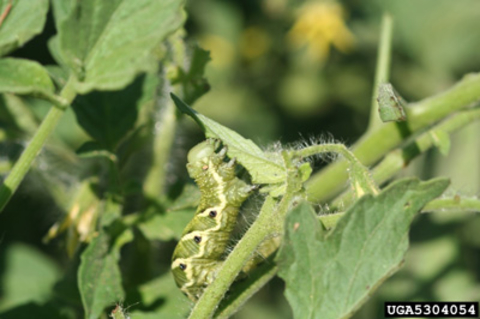Quick facts
- Tomato hornworms are very large caterpillars with a horn-like tail.
- Their favorite plant is tomato.
- Hornworms chew leaves and can completely defoliate plants.
- They can also chew holes in the fruit.
- Physical removal is usually the only necessary management.
How to identify tomato hornworms
(Manduca quinquemaculata)
Caterpillars
- Hornworms are among the largest caterpillars in Minnesota and can measure up to four inches in length.
- Small tomato hornworms are yellow to white in color with no markings.
- Large caterpillars develop eight white, V-shaped marks on each side.
- Tomato hornworms have a black projection or "horn" on the last abdominal segment.
Adult moths
- They are large, heavy-bodied insects with narrow front wings.
- Mottled gray-brown with yellow spots on the sides of the abdomen.
- The moth has a wingspread of four to five inches.
- The hindwings have alternating light and dark bands.
Life cycle of tomato hornworms
- Tomato hornworms survive winters as pupae and emerge as adult moths in spring.
- After mating, females deposit oval, smooth, light green eggs on lower and upper leaf surfaces.
- Caterpillars hatch, begin to feed, and are full-grown in three to four weeks.
- The mature caterpillars drop off plants and burrow into the soil to transform into pupae.
- Moths emerge in two weeks to begin a second generation, during mid-summer.
- Second generation moths deposit eggs on host plants, such as tomato.
- Caterpillars feed until late summer or early fall and then pupate.
- The pupae remain in the soil through winter.
Damage caused by tomato hornworms
- Tomato is the host of choice, but they have also been found on potato, eggplant and pepper.
- There are many weeds that serve as alternate hosts, including horsenettle, jimsonweed and nightshade.
- Large numbers of caterpillars can occur in home gardens and can quickly defoliate plants.
- Tomato hornworm caterpillars start feeding on the leaves on the upper parts of the plants.
- The caterpillars blend in with the leaves and might not be noticed until most of the damage is done.
- As they feed, they create dark green or black droppings that are clearly visible.
- Older tomato hornworms can destroy several leaves as well as the fruit.
- As they become larger, the amount of defoliation increases.
- The last caterpillar stage consumes nearly as much as all the younger stages combined.
How to protect your plants from tomato hornworms
Check plants for tomato hornworms at least twice per week during the summer.
Change the environment to discourage tomato hornworms
- Remove weeds to reduce the number of sites where worms can lay eggs.
- Till the soil after harvest to destroy burrowing caterpillars and pupae.
Pick hornworms off plants
- This is the most effective means of managing them.
- Tomato hornworms are easy to find because of their large size.
- Drop them into soapy water to kill them.
Natural enemies can help manage hornworms
There are many natural enemies of the tomato hornworm.
- General predatory insects such as lady beetles and green lacewings often prey upon the egg stage and on young caterpillars.
- Another important predator is the paper wasp, Polistes spp. This common wasp feeds on many types of caterpillars including those found in gardens.
Tomato hornworms are also parasitized by a number of insects.
- One of the most common is a small braconid wasp, Cotesia congregatus.
- Larvae hatching from wasp eggs are laid on the hornworm.
- The wasp larvae feed on the inside of the hornworm until the wasp is ready to pupate.
- The cocoons look like white rice protruding from the hornworm's body.
- If you see this happening, leave the hornworms in the garden to allow the adult wasps to emerge.
- These wasps kill the hornworms when they emerge from the cocoons.
- Then the wasps look for other hornworms to parasitize.
Using pesticides
Pesticides are generally not necessary. But, if other options are not effective or practical, you may consider applying a product.
It is easier to treat small caterpillars than large ones. Treat tomato hornworms before defoliation is severe.
Low risk pesticides
- Bacillius thuringiensis var. kurstaki (Bt) is a bacterium that occurs naturally in the soil.
- Caterpillars must eat the product for it to be effective.
- It is specific to caterpillars and does not affect other insects including bees.
- It works best on very young caterpillars.
- Spinosad is derived from a naturally occurring soil-dwelling microorganism.
- It affects the nervous system and works well on chewing insects like caterpillars.
- It kills caterpillars when they ingest the product, although there is some effectiveness through contact.
- It is effective for about one to two weeks.
- It is toxic to bees when wet but much less active once it has dried.
- Insecticidal soap is most effective against small caterpillars.
- This product must directly contact them to be effective.
- There is no residual activity so treatment may need to be repeated.
- Insecticidal soap has little or no activity against beneficial insects.
Residual insecticides
- Conventional, or broad-spectrum pesticides, are longer lasting but they can kill beneficial insects.
- Common examples of broad-spectrum pesticides include bifenthrin, cyfluthrin, lambda-cyhalothrin, permethrin, and other pyrethroids.
- One application should be sufficient.
CAUTION: Mention of a pesticide or use of a pesticide label is for educational purposes only. Always follow the pesticide label directions attached to the pesticide container you are using. Be sure that the plant you wish to treat is listed on the label of the pesticide you intend to use. And observe the number of days between pesticide application and when you can harvest your crop. Remember, the label is the law.
Reviewed in 2020






